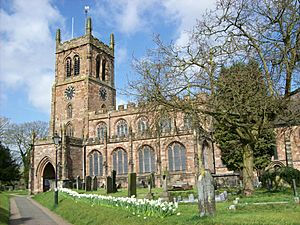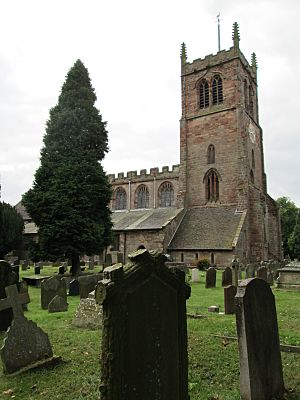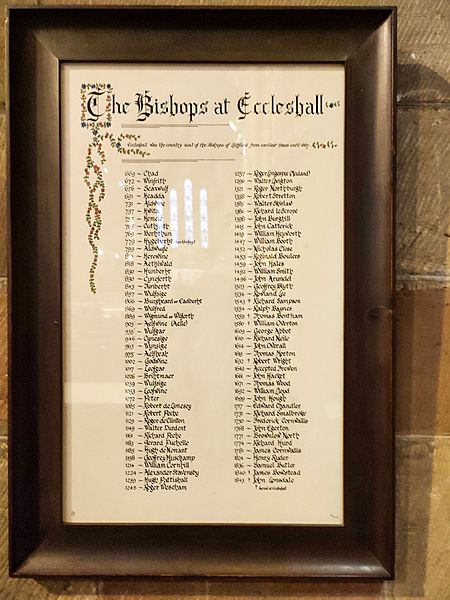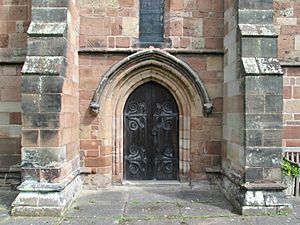Holy Trinity Church, Eccleshall facts for kids
Quick facts for kids Holy Trinity Church, Eccleshall |
|
|---|---|
 |
|
| 52°51′35″N 2°15′26″W / 52.8597°N 2.2573°W | |
| OS grid reference | SJ 827 291 |
| Location | Eccleshall |
| Country | England |
| Denomination | Church of England |
| Website | https://www.eccleshallparish.com/ |
| History | |
| Dedication | Holy Trinity |
| Architecture | |
| Heritage designation | Grade I |
| Designated | 24 January 1967 |
| Style | English Gothic architecture |
| Specifications | |
| Height | 94 feet (29 m) |
| Bells | 8 |
| Administration | |
| Deanery | Eccleshall Deanery |
| Diocese | Diocese of Lichfield |
Holy Trinity Church in Eccleshall, Staffordshire, England, is a very old and important church. It is a Grade I listed building, which means it's protected because of its special history. Most of the church was built in the 1200s. It was also repaired and updated in the 1800s. Inside, you can find the tombs of four important church leaders called Bishops of Lichfield.
Contents
A Look Back in Time
The Domesday Book, a famous survey from 1086, shows that the land where Eccleshall is now belonged to St Chad. This means that even before the Norman Conquest, the land was owned by Lichfield Cathedral. It might have been given to Saint Chad, the first Bishop of Lichfield, way back in the 600s. The name "Eccleshall" itself comes from a Celtic word for church. This suggests there was a Christian community here a very long time ago.
The Church Building
The oldest parts of Holy Trinity Church, like its foundations and pillars, were built around 1189. This was when Hugh Nonant was the Bishop of Lichfield. People think that this new building replaced a smaller, older church from the Norman times.
The main parts of the church, like the chancel (the area around the altar) and the arches that separate the nave from the aisles, are mostly from the 1200s. The upper part of the walls, called the clerestory, was added in the 1400s.
The church tower is about 94 feet (29 meters) tall, reaching the top of its battlements. The tower shows two different styles of English Gothic architecture. Most of it is in the Early English style from the 1200s. The top part was extended in the Perpendicular style from the 1400s. The stone pointy tops, called pinnacles, were added to the tower in 1897. This was to celebrate Queen Victoria's Diamond Jubilee.
Inside the church, there is a sandstone font (a basin for baptisms) that also dates back to the 1200s.
Updates and Changes
Between 1866 and 1869, the church was restored by a famous architect named George Edmund Street. During this time, the roofs of the side aisles were replaced. The north wall was rebuilt, making that aisle wider. The old ceiling of the main part of the church (the nave) was removed, and the roof above it was covered with wooden panels.
In the chancel, the east window was replaced with a new one that has five sections. A new pointed arch was built, and the chancel roof was made higher. The old box-like pews were replaced with new oak seats. At the west end, a special area for baptisms and a room for the choir were built on either side of the tower.
A beautiful screen behind the altar, called a reredos, was added in 1898. It was made to remember Colonel Francis Chambers. This reredos was designed by Basil Champneys.
In 2011, a raised platform was added at the east end of the nave.
The Organ
The church organ was first put in place in 1827. It was rebuilt in 1913 and again in 1930 by a company called Hill, Norman and Beard. The wooden case around the organ, made in 1931, was designed by W. D. Caroe. The organ was last repaired and improved in 2017. This work cost about £60,000.
Important People and Tombs
Holy Trinity Church is the resting place for four Bishops of Lichfield.
- Richard Sampson died in 1554. He was buried near the altar. His tombstone was later moved to the Old Baptistry.
- Thomas Bentham became bishop after Queen Elizabeth I came to power. He died in 1578 and was buried in the chancel. His tombstone was also moved later to the choir vestry.
- The tomb of William Overton, who was bishop from 1579 to 1609, is in the chancel. It has a statue of him lying down, and statues of his two wives kneeling.
- The tomb of James Bowstead, who became bishop in 1840, is in the north-east corner of the chancel. He died at 42 after falling from a horse.
Bishop John Lonsdale, who died in 1867, is buried in the churchyard.
The churchyard also contains five Commonwealth war graves. These are for three British Army soldiers from World War I and a British Army officer and a Royal Navy sailor from World War II.
The Church Bells
In 1547, four bells were hung in the church. In 1710, these were replaced by six new bells, made by Abraham Rudhall I. The lightest of these bells was remade in 1873.
In the 1950s, a new steel frame was put in for eight bells. Two new bells were added as a gift from the Lowe family. There is also a small "sanctus" bell, made in 1735, which was added more recently.
See also
- Grade I listed churches in Staffordshire
- Listed buildings in Eccleshall






